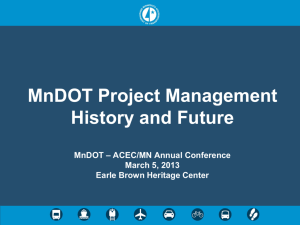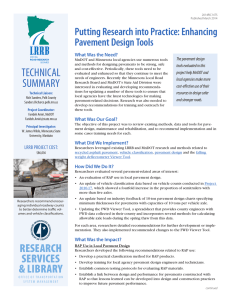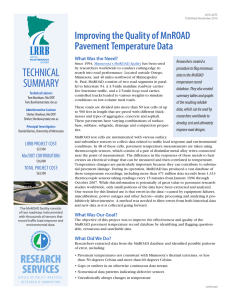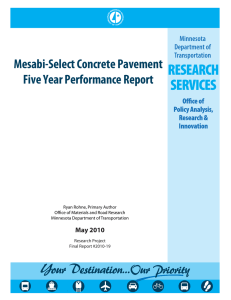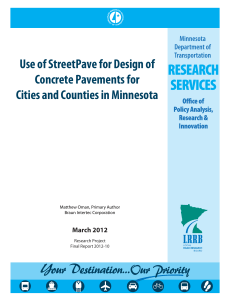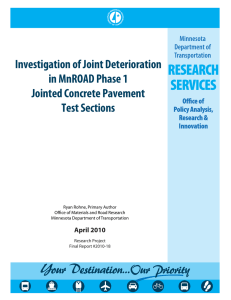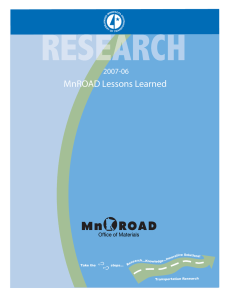RESEARCH SERVICES & LIBRARY Using MnROAD to Advance Sustainable
advertisement
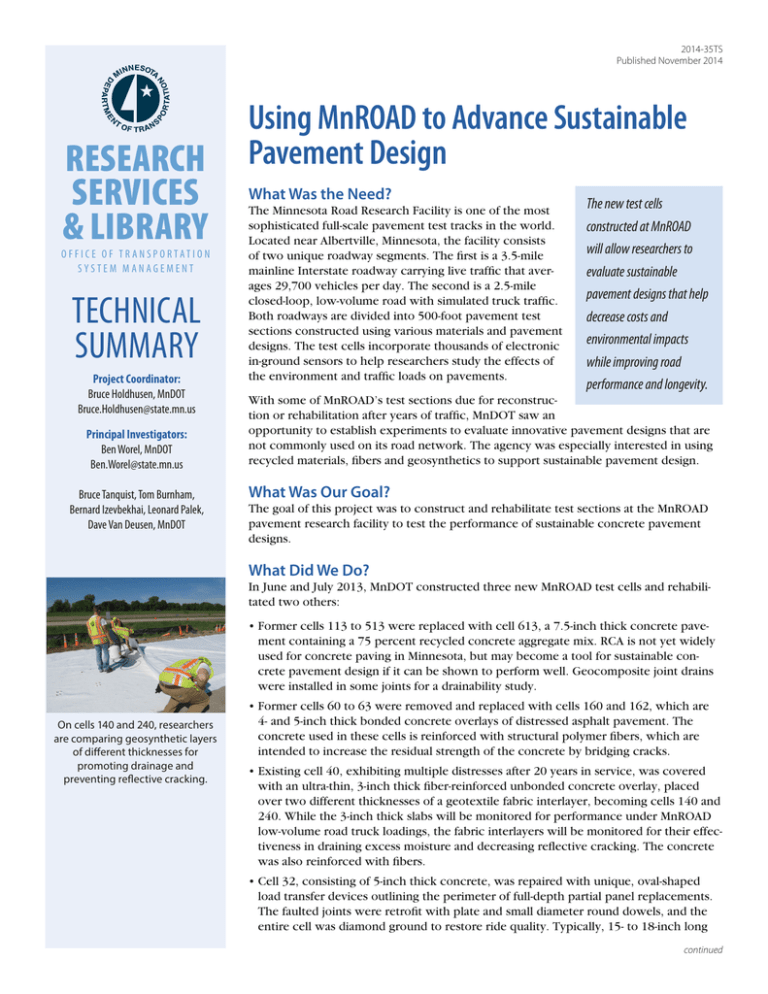
2014-35TS Published November 2014 RESEARCH SERVICES & LIBRARY O FFICE O F TR ANSP O R TATI O N SYSTEM MANAGEMENT TECHNICAL SUMMARY Project Coordinator: Bruce Holdhusen, MnDOT Bruce.Holdhusen@state.mn.us Principal Investigators: Ben Worel, MnDOT Ben.Worel@state.mn.us Bruce Tanquist, Tom Burnham, Bernard Izevbekhai, Leonard Palek, Dave Van Deusen, MnDOT Using MnROAD to Advance Sustainable Pavement Design What Was the Need? The Minnesota Road Research Facility is one of the most sophisticated full-scale pavement test tracks in the world. Located near Albertville, Minnesota, the facility consists of two unique roadway segments. The first is a 3.5-mile mainline Interstate roadway carrying live traffic that averages 29,700 vehicles per day. The second is a 2.5-mile closed-loop, low-volume road with simulated truck traffic. Both roadways are divided into 500-foot pavement test sections constructed using various materials and pavement designs. The test cells incorporate thousands of electronic in-ground sensors to help researchers study the effects of the environment and traffic loads on pavements. The new test cells constructed at MnROAD will allow researchers to evaluate sustainable pavement designs that help decrease costs and environmental impacts while improving road performance and longevity. With some of MnROAD’s test sections due for reconstruction or rehabilitation after years of traffic, MnDOT saw an opportunity to establish experiments to evaluate innovative pavement designs that are not commonly used on its road network. The agency was especially interested in using recycled materials, fibers and geosynthetics to support sustainable pavement design. What Was Our Goal? The goal of this project was to construct and rehabilitate test sections at the MnROAD pavement research facility to test the performance of sustainable concrete pavement designs. What Did We Do? In June and July 2013, MnDOT constructed three new MnROAD test cells and rehabilitated two others: • Former cells 113 to 513 were replaced with cell 613, a 7.5-inch thick concrete pavement containing a 75 percent recycled concrete aggregate mix. RCA is not yet widely used for concrete paving in Minnesota, but may become a tool for sustainable concrete pavement design if it can be shown to perform well. Geocomposite joint drains were installed in some joints for a drainability study. On cells 140 and 240, researchers are comparing geosynthetic layers of different thicknesses for promoting drainage and preventing reflective cracking. • Former cells 60 to 63 were removed and replaced with cells 160 and 162, which are 4- and 5-inch thick bonded concrete overlays of distressed asphalt pavement. The concrete used in these cells is reinforced with structural polymer fibers, which are intended to increase the residual strength of the concrete by bridging cracks. • Existing cell 40, exhibiting multiple distresses after 20 years in service, was covered with an ultra-thin, 3-inch thick fiber-reinforced unbonded concrete overlay, placed over two different thicknesses of a geotextile fabric interlayer, becoming cells 140 and 240. While the 3-inch thick slabs will be monitored for performance under MnROAD low-volume road truck loadings, the fabric interlayers will be monitored for their effectiveness in draining excess moisture and decreasing reflective cracking. The concrete was also reinforced with fibers. • Cell 32, consisting of 5-inch thick concrete, was repaired with unique, oval-shaped load transfer devices outlining the perimeter of full-depth partial panel replacements. The faulted joints were retrofit with plate and small diameter round dowels, and the entire cell was diamond ground to restore ride quality. Typically, 15- to 18-inch long continued “Recycled concrete aggregate is an ongoing area of research for MnDOT and could help in its environmental stewardship and resource management.” —Dave Van Deusen, Research Operations Engineer, MnDOT Office of Materials and Road Research “MnDOT is looking for ways to increase the sustainability of its pavement design, and MnROAD provides a great opportunity for testing alternatives.” —Ben Worel, Research Operations Engineer, MnDOT Office of Materials and Road Research On cell 613, which used RCA, researchers also incorporated drainage fabric under the joints to lessen joint erosion by allowing water to drain away from them. Innovative preformed neoprene joint seals were also installed in many of this cell’s joints. cylindrical retrofitted dowel bars (1 inch in diameter) are used to restore load transfer in concrete pavements with faulted joints. However, with the increasing use of mechanistic-empirical design to build thinner pavements, the required slots for installing these bars would be too deep for thin pavements. Consequently, plate and smaller diameter cylindrical dowels retrofitted in this cell are being monitored for effectiveness. • Cell 39, consisting of a pervious concrete overlay, was diamond ground to determine whether this grinding could be performed without damaging the surface and clogging its pores with the resulting slurry. Researchers will also evaluate associated skid resistance, durability, acoustic properties and ride quality. What Did We Learn? During construction, researchers collected samples of the materials used in the cells and tested for various mechanical properties. Directly after construction, researchers conducted baseline performance testing of surface texture, friction and noise levels. These tests allowed researchers to draw some tentative, preliminary conclusions: • RCA optimum at 75 percent substitution determined by previous MnDOT research was validated. Geosynthetic joint drains were functioning as designed. • Using structural fibers in concrete did not significantly increase its flexural strength. However, the required ATSM 1609 residual strength of 120 psi was achieved with a fiber content of 6.5 pounds per cubic yard. • Deployment of transverse joints beneath the sawcuts was slower, probably due to reduced restraint in the interlayer. • The diamond grinding on cell 39 was successful and did not damage the pavement or clog its pores. Diamond grinding may be a useful restoration tool for pervious concrete. Produced by CTC & Associates for: Minnesota Department of Transportation Research Services & Library MS 330, First Floor 395 John Ireland Blvd. St. Paul, MN 55155-1899 651-366-3780 www.mndot.gov/research What’s Next? Researchers will continue to monitor cell surface texture, friction and noise levels, as well as signs of distress such as cracking. They will also conduct field tests for such characteristics as strength, stiffness and ride quality, and will collect data from sensors installed on the cells to measure temperature, moisture and strain. Data from MnROAD cells is typically used in a variety of research projects for MnDOT, the Local Road Research Board and other state departments of transportation as well as for federally supported transportation pooled fund studies. This Technical Summary pertains to Report 2014-35, “2013 MnROAD Construction Report,” published October 2014. The full report can be accessed at http://www.lrrb.org/PDF/201435.pdf.


